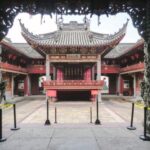Huatan Village serves as the seat of Hutan Township, with Zhongshan Mountain to its back and Zhenxi River to its front. In the past, there was a garden behind the village, hence the name Huatan, which was later mistakenly referred to as Hutan. The village was once inhabited by the surnames Huang, Ke, Chen, Ma, and others, and now there are approximately 600 households of the Zhu family. At the beginning of the Northern Song Dynasty, the progenitor of the Zhu family, Zhu Xing, served as the county magistrate of Yongjia for two years.
Seeing the chaos and rampant banditry, he chose to disregard fame and order, and after careful selection, settled in Hutan, a place described as having clear mountains and waters, harmonious birdsong, deep forests, and secluded scenery. Since then, the Zhu family has flourished. Over the centuries, Hutan Village has been a cradle of culture and talent. Originally, there was a fortress wall made of raw stones and four stone arch gates surrounding Hutan Village. A section of the wall to the east of the village and one arch gate to the west remain. There were originally 12 archways, mostly built to honor scholars, but they have been destroyed over time. A main street paved with pebbles divides the village into roughly equal halves from west to east, with the northern half being the built-up area and the southern half being farmland (which has gradually been replaced by new residential buildings in recent years), making the main street the southern facade of the built-up area. This street is home to the village’s important buildings, including the only remaining Dunmu Ancestral Hall and Xiantai Ancestral Hall, as well as Guifang Hall and Chen’s Chancellor’s Mansion. Additionally, at the north end of a small alley in Ma Wan, Hutan Village, there are three ancient residences. One is on the west side, a long, single-story building with seven bays. The other two are on the east side, one being a long, five-bay residence, and the other a quadrangle compound with a total of 24 rooms. There is a well in the backyard, with the well ring inscribed with ‘Great Song Baoqing Year Two Bingxu (1226)’, which is still faintly discernible. The villagers refer to these residences as ‘Song Houses’. The village also has cultural relics such as Xiyuan Academy, Baiyan Academy, and Wenchang Pavilion. The entire text is open all year round and accessible 24/7.Huatan Village
Huatan Village serves as the seat of Hutan Township, with Zhongshan Mountain to its back and Zhenxi [...]









